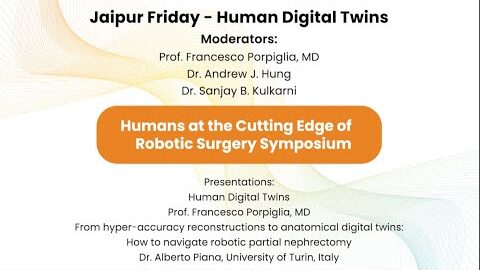#341 Vesicoscopic Robotic Assisted Ureteric Reimplantation in Children… Dr. M. S. Ansari
This is one of the 2023 KS International Innovation Awards videos selected for inclusion in the Vattikuti Foundation – ORSI Humans at the Cutting Edge of Robotic Surgery Conference, October 6, 7 & 8, 2023 in Ghent, Belgium. Posting does not imply that is has been selected as a Finalist, just that the content will be discussed at the Conference.
From the entry: Vesicoscopic Robotic Assisted Ureteric Reimplantation in Children: Technical feasibility and ergonomic superiority
Author: Dr MS Ansari Introduction Many surgeons experience work-related pain and musculoskeletal symptoms. Neck strain, back strain/pain and lower extremity exertion have been reported up to 20-40% of the surgeons in open surgeries.
Objective We sought to evaluate the feasibly of surgeons’ work-related musculoskeletal symptoms in comparison to open surgery
Materials and Methods Sanjay Gandhi postgraduate Institute of Medical Sciences, Lucknow-India Robot-assisted surgery has been reported to provide many benefits over open surgeries to the patient and surgeon. vesicoscopic robotic assisted ureteric reimplantation (VRAUR) in children and The children under 12 years of age with vesicoureteric reflux (VUR underwent open (Group I) and vesicoscopic robotic assisted ureteric reimplantation (VRAUR) (Group II). All surgeries were performed by a single surgeon. For VRAUR the patient was placed in a dorsal lithotomy position. Four ports (Two 8-mm working ports were placed in a straight line drawn along the anterior superior iliac spine and one endoscopic (middle) 12 mm [Intuitive Surgical, Sunnyvale, CA], was placed 2 cm above the same line and the fourth assistant port of 3 mm was placed 2 cm below the line.
The surgeons related ergonomic parameters recorded in both the groups were generalised pain, neck and back strain/pain along with lower extremity exertion to surgeons. Success was defined as the absence of VUR on direct radionuclide cystogram at 12 weeks.
Results The median age of the children was 4.5 and 5.1 in groups I and II respectively. Both the groups had 30 of patients each. The grades of VUR was comparable in both the groups. The VRAUR procedure could be accomplished in all the cases without any slippage of robotic ports or clashing of arms except in 2-year-old that without any conversion. The 2-yr-old child with bladder capacity of 150 cc posed little difficulty due to space restriction and slight clashing of arms that lengthened the procedure but could be completed successfully.
Conclusions Vesicoscopic robotic assisted ureteric reimplantation is feasible and the procedure follows the anatomical principles thus minimizing the possibility of neuro urological damage and subsequent bladder dysfunction. The technique offers success rate comparable to open surgery. The s musculoskeletal symptoms recorded were substantially more in The Surgeons’ Group I as compared to Group II (p value 0.03, OR 3.9 [1.9-5.4). related to musculoskeletal symptoms are more substantial in urgical ergonomics open surgery.
See more at: https://vattikutifoundation.com/videos/
Date
August 15, 2020






